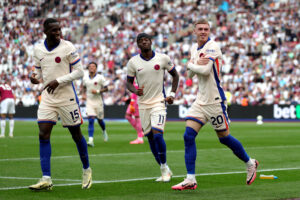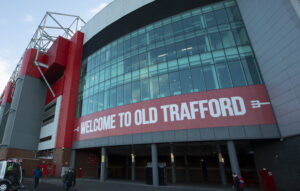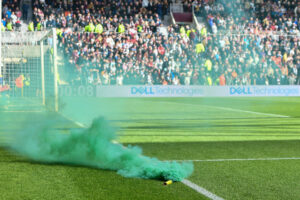England host Iceland on Wednesday night in a UEFA Nations League dead rubber. After losing to Belgium 2-0 at the weekend, Gareth Southgate’s side are out of contention for the competition’s final stage. Iceland, winless and pointless after five matches, occupy the sole relegation berth.
Amid a global pandemic, and with clubs reeling under the weight of congested fixture schedules, it is realistic to question the reasoning behind the staging of a fixture with nothing at stake but pride.
However, for Southgate – and England – it presents the perfect opportunity to flex England’s attacking muscle and end the international break on a high.
England v Iceland: Forward Players Key to Ending 2020 With a Win
Belgium Defeat Exposes Limitations of England’s Overly Defensive Formation
Lining up in Leuven with Southgate’s favoured back three system (3-4-2-1) – a formation designed to provide defensive stability against the top sides – England completely dominated the ball. 55 per cent possession, 589 passes (102 more than Belgium) with 87 per cent accuracy, and 16 shots compared to the host’s eight.
However, only three of those efforts were generously categorised as on target in a frustrating night for England in the final third. Playing as a solo striker, Harry Kane looked isolated down the middle and ran himself ragged trying to re-create the goal delivering form seen week in week out for Tottenham Hotspur. Jack Grealish, grasping his first competitive opportunity with both hands, was England’s brightest creative spark, but neither he nor the admirable Mason Mount, could provide the all-important breakthrough.
That was the extent of England’s forward play. Behind them lay seven defensively-minded bodies – including the midfield pairing of Declan Rice and Jordan Henderson, and the questionable selection of Eric Dier as centre-back anchor – leaving England chronically short of pace and pizzazz.
Meanwhile on the bench, unused until deep into the second period, sat a wealth of attacking talent. Jadon Sancho, Dominic Calvert-Lewin, Tammy Abraham and Phil Foden. Languishing on the sidelines, tracksuit-clad understudies, for 69 painful minutes.
It was a display endemic of recent international breaks. Dominating possession in the centre of the park, plenty of bodies in between the opposition and Jordan Pickford, but missing something in the final third.
It’s easy to blame England’s recent performances on the absence of star forwards, most pointedly pacemen Marcus Rashford and Raheem Sterling, but in reality, the problem is the system, not the players. In short, England’s defensive mindset is stifling the very forward flair Southgate entranced the nation with at Russia 2018.
England v Iceland: Several Forward Thinking Formations at Southgate’s Disposal
When Southgate puts pen to paper for his team sheet to face Iceland, there should only be one thought on his mind: goals. Despite possessing a talent pool unseen since the so-called Golden Generation, England have scored just three times in five Nations League matches.
The England boss needs to rediscover his side’s goalscoring mojo before the doubters start massing and a glorified friendly against Iceland is the perfect opportunity to throw caution (and the defensive back three) to the wind.
Here are three options that England could deploy at Wembley to showcase their attacking arsenal and bow out of 2020’s internationals with a blockbuster win.
4-1-4-1
Pickford/Pope; Saka, Mings, Maguire, Trippier; Rice; Grealish, Winks, Mount, Sancho; Kane
Leaving aside the goalkeeper debate and the whys and wherefores of England’s defensive partnership, this formation gives Southgate’s side balance. There’s the defensive unit, anchored by Declan Rice, and the forward unit built around Harry Kane.
A player always looking for the ball and getting into space, Grealish provides pace and creativity down the left which Sancho can match on the right. Mount, deployed in the central role he excelled in against Ireland, provides a threat down the middle whilst Harry Winks is the glue holding the systems together.
Given offensive freedom with Rice acting as sweeper, Winks can also drop back to provide defensive cover for the marauding runs of Kieran Trippier and Bukayo Saka, preventing England from being overrun on the counter.
Attacking support from all angles for Kane, speed down the wings to prevent the ball from stagnating in possession and defensive cover without the negativity. It’s by no means England’s strongest 11 but this formation would provide the x-factor at both ends of the park.
4-3-3
Pickford/Pope; Saka, Mings, Maguire, Trippier; Mount, Rice, Foden; Grealish, Kane, Sancho
Due to England’s injuries and withdrawals, this is a riskier line-up but one that is not without its merits.
With Ben Chilwell likely to be rested, Saka retains the left-back berth instead of occupying the left of the midfield three. Mount and Foden, therefore, flank Rice (once again, the defensive powerhouse in midfield) with Grealish, Kane and Sancho upfront.
The emphasis of this formation is very much attack, with Foden providing offensively what Winks adds defensively, which does mean there is potential for England to find themselves under pressure at the back. However, with Iceland also short of goals and confidence, this shouldn’t be too much of an issue at Wembley.
Kane and Calvert-Lewin: A Potentially Deadly Duo
With eight goals in eight Premier League appearances this season, it seems criminal that Calvert-Lewin hasn’t played a bigger part for England during this international break. True, Kane is near undroppable as England’s number nine and neither player has a strike partner at club level, but the prospect of the Premier League’s two best strikers in the same starting line-up is tantalising.
The duo got a brief run-out together as England chased the game against Denmark in October but are deserving of a proper opportunity to test their compatibility. One option would be to slot Calvert-Lewin into the front three alongside Grealish and Kane, tweaking the familiar 4-3-3 to accommodate both players.
Alternatively, England could opt for a simple 4-4-2. Supported by a midfield four of Grealish-Rice-Mount-Sancho, Kane would be the number ten to Calvert Lewin’s target man. A system designed to exploit their respective talents, the pair can interchange provider and goalscorer duties whilst giving Grealish and co. extra heads to aim at. A deadly combination.
Main Photo






